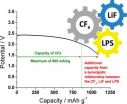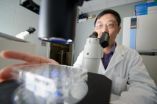(Press-News.org) OAK RIDGE, Tenn., April 24, 2014 — Researchers at the Department of Energy's Oak Ridge National Laboratory have developed a new and unconventional battery chemistry aimed at producing batteries that last longer than previously thought possible.
In a study published in the Journal of the American Chemical Society, ORNL researchers challenged a long-held assumption that a battery's three main components -- the positive cathode, negative anode and ion-conducting electrolyte -- can play only one role in the device.
The electrolyte in the team's new battery design has dual functions: it serves not only as an ion conductor but also as a cathode supplement. This cooperative chemistry, enabled by the use of an ORNL-developed solid electrolyte, delivers an extra boost to the battery's capacity and extends the lifespan of the device.
"This bi-functional electrolyte revolutionizes the concept of conventional batteries and opens a new avenue for the design of batteries with unprecedented energy density," said ORNL's Chengdu Liang.
The team demonstrated the new concept in a lithium carbon fluoride battery, considered one of the best single-use batteries because of its high energy density, stability and long shelf life. When ORNL researchers incorporated a solid lithium thiophosphate electrolyte, the battery generated a 26 percent higher capacity than what would be its theoretical maximum if each component acted independently. The increase, explains Liang, is caused by the cooperative interactions between the electrolyte and cathode.
"As the battery discharges, it generates a lithium fluoride salt that further catalyzes the electrochemical activity of the electrolyte," Liang said. "This relationship converts the electrolyte -- conventionally an inactive component in capacity -- to an active one."
The improvement in capacity could translate into years or even decades of extra life, depending on how the battery is engineered and used. Longer-lived disposable batteries are in demand for applications such as such as artificial cardiac pacemakers, radiofrequency identification devices, remote keyless system, and sensors, where replacing or recharging a battery is not possible or desirable.
"If you have a pacemaker, you don't want to undergo surgery every 10 years to replace the battery," Liang said. "What if a battery could last 30 to 50 years? Our fundamental research is opening up that possibility through a new design mechanism."
INFORMATION:
The study is published as "Pushing the Theoretical Limit of Li-CFx Batteries: A Tale of Bi-functional Electrolyte." Coauthors are ORNL's Ezhiylmurugan Rangasamy, Juchuan Li, Gayatri Sahu, Nancy Dudney and Chengdu Liang. The work was sponsored by the Division of Materials Sciences and Engineering in DOE's Office of Science.
The materials synthesis and characterization for the study were conducted at the Center for Nanophase Materials Sciences. CNMS is one of the five DOE Nanoscale Science Research Centers supported by the DOE Office of Science, premier national user facilities for interdisciplinary research at the nanoscale. Together the NSRCs comprise a suite of complementary facilities that provide researchers with state-of-the-art capabilities to fabricate, process, characterize and model nanoscale materials, and constitute the largest infrastructure investment of the National Nanotechnology Initiative. The NSRCs are located at DOE's Argonne, Brookhaven, Lawrence Berkeley, Oak Ridge and Sandia and Los Alamos national laboratories. For more information about the DOE NSRCs, please visit http://science.energy.gov/bes/suf/user-facilities/nanoscale-science-research-centers/.
ORNL is managed by UT-Battelle for the Department of Energy's Office of Science.
DOE's Office of Science is the single largest supporter of basic research in the physical sciences in the United States, and is working to address some of the most pressing challenges of our time. For more information, please visit science.energy.gov.
Image: http://www.ornl.gov/Image%20Library/Main%20Nav/ORNL/News/News%20Releases/2014/CFX_highres.jpeg?code=104e29f1-6c23-4c58-ba9f-41c72ec0b863
Cutline: When ORNL researchers incorporated a solid lithium thiophosphate electrolyte into a lithium-carbon fluoride battery, the device generated a 26 percent higher capacity than what would be its theoretical maximum if each component acted independently.
NOTE TO EDITORS: You may read other press releases from Oak Ridge National Laboratory or learn more about the lab at http://www.ornl.gov/news. Additional information about ORNL is available at the sites below:
Twitter - http://twitter.com/oakridgelabnews
RSS Feeds - http://www.ornl.gov/ornlhome/rss_feeds.shtml
Flickr - http://www.flickr.com/photos/oakridgelab
YouTube - http://www.youtube.com/user/OakRidgeNationalLab
LinkedIn - http://www.linkedin.com/companies/oak-ridge-national-laboratory
Facebook - http://www.facebook.com/Oak.Ridge.National.Laboratory
'Double-duty' electrolyte enables new chemistry for longer-lived batteries
2014-04-24
ELSE PRESS RELEASES FROM THIS DATE:
Cell resiliency surprises scientists
2014-04-24
EAST LANSING, Mich. --- New research shows that cells are more resilient in taking care of their DNA than scientists originally thought. Even when missing critical components, cells can adapt and make copies of their DNA in an alternative way.
In a study published in this week's Cell Reports, a team of researchers at Michigan State University showed that cells can grow normally without a crucial component needed to duplicate their DNA.
"Our genetic information is stored in DNA, which has to be continuously monitored for damage and copied for growth," said Kefei Yu, ...
Vanderbilt study finds physical signs of depression common among ICU survivors
2014-04-24
Depression affects more than one out of three survivors of critical illness, according to a Vanderbilt study released in The Lancet Respiratory Medicine, and the majority of patients experience their symptoms physically rather than mentally.
It is one of the largest studies to investigate the mental health and functional outcomes of critical care survivors, according to lead author James Jackson, Psy.D., assistant professor of Medicine, and it highlights a significant public health issue, with roughly 5 million patients admitted to intensive care units (ICUs) in the United ...
Study: Altruistic adolescents less likely to become depressed
2014-04-24
CHAMPAIGN, Ill. — It is better to give than to receive – at least if you're an adolescent and you enjoy giving, a new study suggests.
The study found that 15- and 16-year-olds who find pleasure in pro-social activities, such as giving their money to family members, are less likely to become depressed than those who get a bigger thrill from taking risks or keeping the money for themselves.
The researchers detail their findings in the Proceedings of the National Academy of Sciences.
The study focused on the ventral striatum, a brain region that regulates feelings of ...
Take notes by hand for better long-term comprehension
2014-04-24
Dust off those Bic ballpoints and college-ruled notebooks — research shows that taking notes by hand is better than taking notes on a laptop for remembering conceptual information over the long term. The findings are published in Psychological Science, a journal of the Association for Psychological Science.
Walk into any university lecture hall and you're likely to see row upon row of students sitting behind glowing laptop screens. Laptops in class have been controversial, due mostly to the many opportunities for distraction that they provide (online shopping, browsing ...
Amazon rainforest survey could improve carbon offset schemes
2014-04-24
Carbon offsetting initiatives could be improved with new insights into the make-up of tropical forests, a study suggests.
Scientists studying the Amazon Basin have revealed unprecedented detail of the size, age and species of trees across the region by comparing satellite maps with hundreds of field plots.
The findings will enable researchers to assess more accurately the amount of carbon each tree can store. This is a key factor in carbon offset schemes, in which trees are given a cash value according to their carbon content, and credits can be traded in exchange ...
The blood preserved in the pumpkin did not belong to Louis XVI
2014-04-24
The work has been published in the Scientific Reports journal.
CSIC researcher Carles Lalueza-Fox, from the Institute of Evolutionary Biology (a joint centre of CSIC and Pompeu Fabra University-UPF), explains: "When the Y chromosome of three living Bourbons was decoded and we saw that it did not match with the DNA recovered from the pumpkin in 2010, we decided to sequence the complete genome and to make a functional interpretation in order to see if the blood could actually belong to Louis XVI".
The functional genome analysis was based on two main points, the genealogical ...
Study supports safety of antimicrobial peptide-coated contact lenses
2014-04-24
Philadelphia, Pa. (April 24, 2014) - Contact lenses coated with an antimicrobial peptide could help to lower the risk of contact lens-related infections, reports a study in Optometry and Vision Science, official journal of the American Academy of Optometry. The journal is published by Lippincott Williams & Wilkins, a part of Wolters Kluwer Health.
Studies in animals and now humans support the biocompatibility and safety of lenses coated with the antimicrobial peptide melimine, according to the new research by Debarun Dutta, B.Optom, of The University of New South Wales, ...
Take the bat, leave the candy
2014-04-24
WINSTON-SALEM, N.C. – April 24, 2014 – 'Take me out to the ballgame' doesn't exactly conjure up images of apple slices and kale chips. The more likely culprits include French fries, soda and the occasional box of Crackerjacks.
Unfortunately for children who play youth baseball, eating unhealthy food during practices and games may be contributing to weight problems, according to researchers at Wake Forest Baptist Medical Center. The study, published in the current online edition of Childhood Obesity, found that high-calorie snacks and sugar-sweetened drinks dominate the ...
New approach for surgery patients cuts hospital stays and costs
2014-04-24
DURHAM, N.C. – Changes in managing patients before, during and after colorectal surgery cut hospital stays by two days and reduced readmission rates, according to researchers who led a study of the approach at Duke University Hospital.
The practice, called enhanced recovery, is easier on patients before surgery, doing away with the fasting period and bowel evacuation that are typically prescribed. After surgery, patients are encouraged to eat and move about as soon as possible, leading to faster recoveries.
Among findings published in the May 2014 issue of the journal ...
Paying closer attention to attention
2014-04-24
Ellen's (not her real name) adoptive parents weren't surprised when the school counselor suggested that she might have attention deficit hyperactivity disorder (ADHD). Several professionals had made this suggestion over the years. Given that homework led to one explosion after another, and that at school Ellen, who is eleven, spent her days jiggling up and down in her seat, unable to concentrate for more than ten minutes, it seemed a reasonable assumption. Yet her parents always felt that ADHD didn't quite capture the extent of Ellen's issues over the years. Fortunately ...



